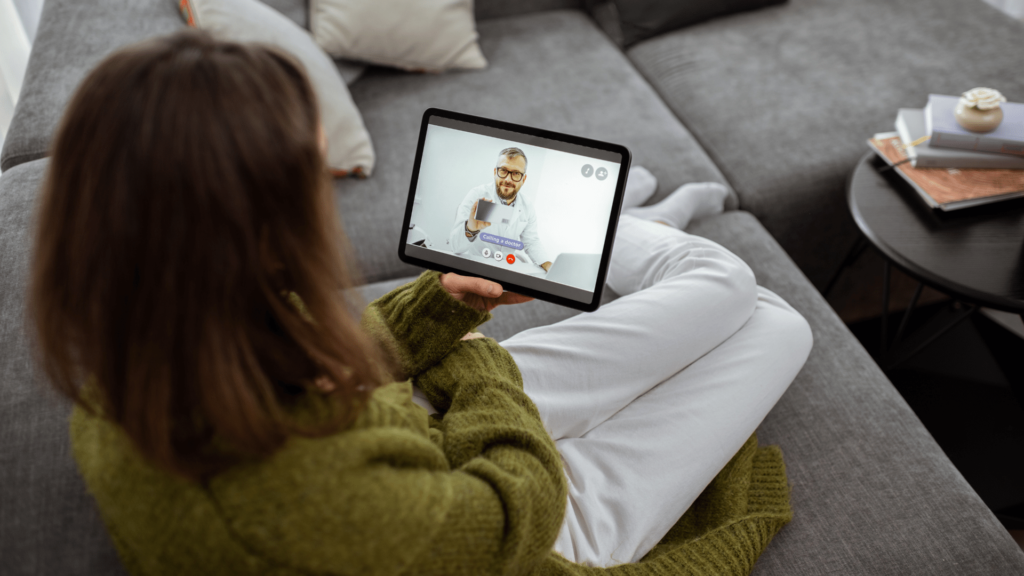Website Design by Transitional Web Design LLC, An Atlanta-based website design and marketing company
Telemedicine for Diabetes
Diabetes is a significant illness in the United States today, reaching epidemic levels throughout the world. In 2015 an estimated 30.0 million people, comprising 9.4% of the population, had diabetes in the U.S. These numbers are continually rising with an estimated 1.5 million new diagnoses every year[1]. This disease causes many health complications and has a high mortality rate.
If you live with diabetes, then you know how difficult it can be to manage your disease while living your busy life. Between work and family responsibilities it can be challenging to squeeze in lab work and doctors’ appointments let alone monitoring daily blood sugar levels.
The goal of diabetes treatment is to achieve control of your blood glucose levels and blood pressure levels, substantially eliminating the causes of most complication associated with the disease. The most effective programs for diabetes management involve close monitoring your health data (blood glucose levels, A1,etc.), patent education, and empowering self-care{2}.
Close monitoring, however, can be both costly and time-consuming, decreasing your likelihood to remain compliant with the regime. Do you ever wonder if there is an easier way? By using telemedicine, your diabetes can be closely monitored without significant disruptions to your life and route, and data can be closely followed with minimal effort.
Telemedicine interventions such as virtual visits, remote patent monitoring devices and apps, texting and web-based communication tools can be applied to your diabetes care, making a significant impact on not only the cost of treatment but also on improved health outcomes.
Lower Cost
The costs of diabetes are high, estimated at $245 billion in the US in 2012. Average medical costs for people with diabetes are around $13,000 per year, on average more than double that of people without the disease{3}.
The high cost of treatment and the cost of monitoring for complication puts a burden on people with diabetes, especially for those in poverty. These expenses could affect your ability to attend appointments and remain compliant with a treatment plan.
Healthcare costs can be significantly reduced when telemedicine is a part of the treatment plan. In one study Medicare patents were put in a pilot program using telemedicine to manage diabetic care and were compared to a similar group that was not participation in the program. The costs for the participants in the pilot study were between 7 .7 % and 13.3% lower than those of the nonparticipants{4}. In addition to direct healthcare costs, using telemedicine for diabetes treatment can save the cost of travel and lost time at work, enabling you to attend appointments and consultations remotely and at a convenient time.
Better outcomes
Diabetes is well suited for treatment with telemedicine. Much of your diabetic data can be easily digitalized and sent to the health practitioner electronically such as blood glucose levels, exercise, and food intake. Many programs and apps exist that can automatically send this information to the healthcare provider where they can track and analyze trends.
Studies show that successful treatment for diabetes requires close monitoring of a patent’s health data and lifestyle choices, intervening early before significant health problems arise. Furthermore, recognizing trends in blood glucose levels can enable you to avoid and prevent episodes of low blood sugar, increasing safety and providing more freedom and flexibility in their daily lives.
Studies show that patents are more likely to be compliant with care and achieve beter outcomes when using telemedicine. The HgbA1C (A1C) is a laboratory test that is widely used to monitor diabetes management as it gives a picture of blood sugars over a period of a few months, instead of merely looking at the Current blood sugar. Higher A1C levels are associated with more health complication such as neuropathy or kidney failure. A systematic review demonstrated that telemedicine consistently reduced A1C levels compared to controls, especially in those with type 1 diabetes[5} . The close monitoring done with telemetric not only enabled the healthily provider to recognize trends and intervene early but kept the patents accountable for their choice, improving the likelihood of compliance with the regime.
One such study{6} compared a control group that was treated with a traditional treatment at a doctor’s office with a telemedicine group where participants had to upload their blood glucose levels regularly as well as other health behaviors such as exercise, smoking and food and alcohol intake. The researchers then monitored the blood glucose levels and the health behaviors, providing intervention when necessary. After 3 months, patents in the telehealth group had better control on their blood glucose levels, had fewer blood sugar lows, and improved A1C levels compared to the control group.
Diabetes is a significant health problem, causing many health complication. Close monitoring can positively affect the effects of the disease, helping to normalize blood sugar levels and A1C levels, but can it can be very costly and time-consuming. Telemedicine is a great way to manage your diabetes, saving money and making monitoring and follow up visits more convenient and useful.
If you suffer from diabetes and are looking for a more convenient way to manage your disease, consider using telemedicine. Dr. Brandy and her team at Extraordinary Healthcare can help you manage your Diabetes and help to prevent further complication. Together you can get control of your diabetes and help you live a happier, healthier life.
Reference:
[1] https://www.cdc.gov/diabetes/pdfs/data/statistics/national-diabetes-statistics-report.pdf
[2] https://nline.liebertpub.cm/doi/abs/10.1089/tmj.2010.0113
[3} https://www.cdc.gov/diabetes/pdfs/data/statistics/national-diabetes-statistics-report.pdf
[4] https://www.healthaffairs.org/doi/abs/10.1377/hlthaff.2011.0216
[5] http://journals.plos.org/plosone/article?id=10.1371/journal.pone.0079246#B4
[6] https://www.ncbi.nlm.nih.gov/pmc/articles/PMC4313963/
The post Telemedicine for Diabetes appeared first on Extra Ordinary Family Healthcare.









